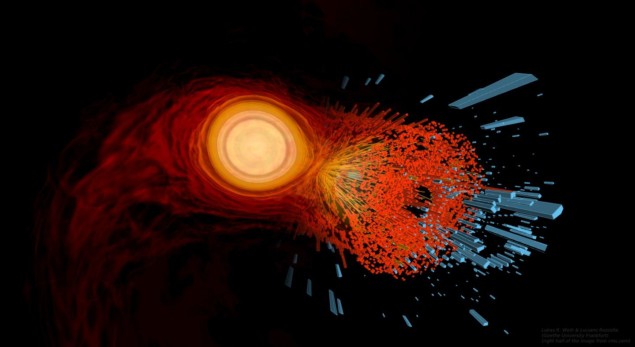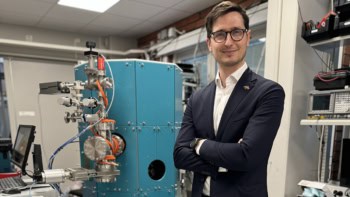
Gravitational waves from neutron star mergers could provide vital information for testing theories of the quark-gluon plasma — a hot and dense state of matter that is thought to have existed in the very early universe. That is the conclusion of physicists in Germany, who have done computer simulations of how a quark-gluon plasma could be formed when such mergers occur.
In August 2017, the LIGO-Virgo observatories made the first-ever detection of gravitational waves from two merging neutron stars. Another merger has been since observed and more are expected — so physicists are very keen to study these gravitational-wave signals to gain insights into the violent processes that occur at the point of merger.
Quantum chromodynamics was developed in the 1960s by Murray Gell-Mann and others. It explains how, under normal conditions, the strong nuclear force causes quarks to be confined by gluons to create discrete particles called hadrons – which include protons and neutrons. At sufficiently high temperatures and pressures, however, the hadrons dissolve into a soup of free quarks and gluons known as quark-gluon plasma or quark matter. The first convincing observations of the quark-gluon plasma were made about 20 years ago by smashing lead ions together at CERN. Since then, minute quantities of the stuff have been made at other accelerators and studied in greater detail.
Quark epoch
The quark-gluon plasma is also of great interest to physicists who study the early universe, which some models describe as have a “quark epoch” from about 10−12-10−6 s after the Big Bang. Too hot and dense for quarks to be bound into hadrons, the universe in the quark epoch is thought to have comprised a quark-gluon plasma. Understanding the detailed properties of this state of matter therefore helps cosmologists model the universe’s evolution further back towards the Big Bang.
An open question is whether stable quark-gluon plasma exists naturally in the observable universe today. “In 1984, Edward Witten proposed that quark matter is the fundamental state of matter,” explains theoretical astrophysicist Luciano Rezzolla of the Institute for Theoretical Physics in Frankfurt. Many astrophysicists had once believed that entire stars can be made of quark matter, but more recent observations have made this a minority view: “If you asked a roomful of scientists how many of them think pure quark stars exist, you would find only a few hands raised,” says Rezzolla.
More plausible, explains Rezzolla’s PhD student Lukas Weih, are hybrid stars with “degenerate quarks in the centre where the pressure is highest, and then around this a normal neutron star”. The neutron stars with the highest central pressure would be the heaviest ones, which raises the intriguing possibility of two lighter neutron stars in a binary orbit merging and undergoing a phase transition to a such a heavy hybrid star. However, there is little agreement on under what circumstances, or exactly how, this would occur.
Gradual phase transition
In the new research, Rezzolla, Weih and Matthias Hanauske compared computer models of mergers between binary neutron stars with equal masses either 2.64 or 2.68 times that of the Sun. The models predicted the gravitational wave signals produced in such mergers. The signals produced if no phase transition occurs, or if an immediate phase transition occurs on merger, had been previously calculated by other research groups. The Frankfurt researchers simulated a phase transition-triggered core-collapse leading to black hole formation; and a gradual post-merger phase transition to a hybrid neutron star with a quark-gluon plasma in its centre.

Quark deconfinement drives supernovae in blue supergiant stars, say astrophysicists
If no phase transition occurs, for example, the frequency of the gravitational waves after the merger should remain constant over time. If the star undergoes a gradual phase transition, however, their frequency should climb over the course of a few milliseconds: “Also, if you do some signal processing, you will find that the purely hadronic case gives you one peak in the frequency spectrum,” explains Weih, , “whereas if there is a [gradual] phase transition to quark-gluon plasma, you also get a second peak.”
The research is described in a paper in Physical Review Letters. “This is a very interesting paper,” says astrophysicist David Radice at Pennsylvania State University in the US: “It’s not the first paper to look at the impact of phase transitions in neutron star binaries, but people in the past have taken one particular model for how matter should behave at high densities and performed simulations with that. But there are many different models all predicting different things, and here they’ve parameterized this uncertainty and considered all possibilities.” He cautions, however, that interpretation of gravitational wave data is an embryonic art: “Many things are uncertain,” he says, “For example, there may be reasons why two characteristic frequencies appear in the post-merger signal that have nothing to do with a phase transition.”



